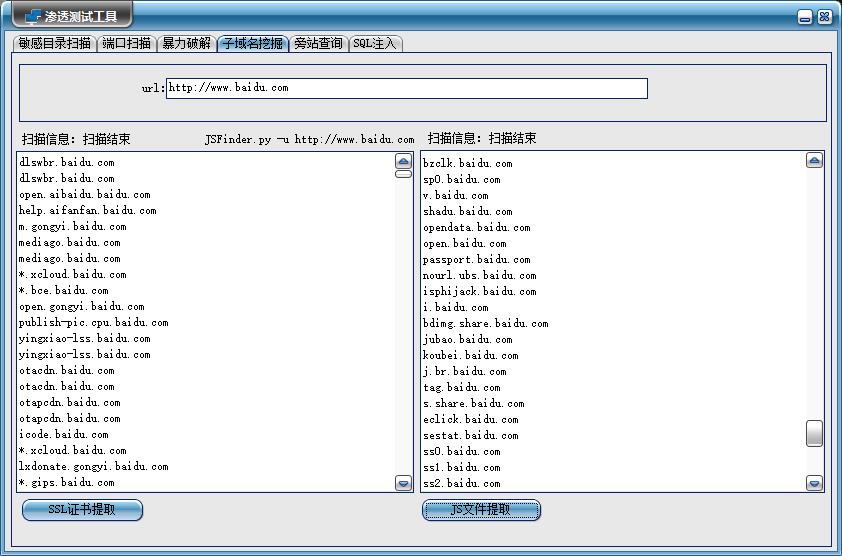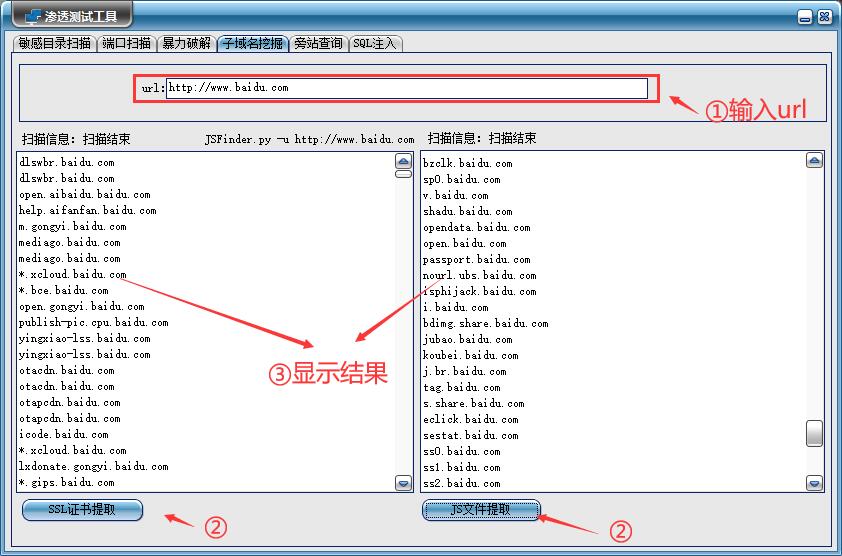使用C#winform編寫滲透測試工具--子域名挖掘
這篇文章主要介紹使用C#winform編寫滲透測試工具--子域名挖掘。在滲透測試中,子域名的收集十分重要,通常一個網站的主站的防禦能力特別強,而他們的非主站相對較弱,我們便可以通過收集子站資訊從而擴大攻擊範圍,增大滲透的可能。
- 下面是使用C#winform編寫的滲透測試工具,前面我們已經完成了埠掃描、敏感目錄掃描和暴力破解的工作,這一部分將介紹如何實現子域名挖掘。

目錄
- 各種子域名挖掘技術
- 程式碼實現
- 使用步驟
一、各種子域名挖掘技術
字典爆破
- 字典爆破就是通過收集來的字典,拼接到頂級域名前面,然後通過自動化工具進行訪問,判斷返回結果,從而跑出子域名是否存在。比如ESD,subDomainsBrute。
證書SSL查詢
- 因為SSL證書支援證書透明度,而SSL裡包含子域名。證書SSL查詢就是通過HTTPS 證書,ssl證書等蒐集子域名記錄。比如網站cet就是從SSL證書收集子域名。
DNS資料
- DNS原理就是蒐集DNS的解析歷史,通過查詢dns記錄來獲取到對方的解析記錄,從而獲取到子域名,正常來說你的域名經DNS解析過一般就會搜到。比如virustotal執行DNS解析來構建資料庫,來檢索子域名。
爬蟲提取子域名(js檔案提取)
- 利用爬蟲從頁面原始碼中提取子域名,比如JSFinder。
二、程式碼實現
這裡分別使用兩種方式實現子域名的挖掘,即通過證書SSL查詢和js檔案提取。
1.使用證書SSL查詢方式
# !/usr/bin/env python3# -*- coding: utf-8 -*-import sysimport urllib.requestimport urllib.parseimport reimport sslssl._create_default_https_context = ssl._create_unverified_contextdef crt_domain(domains):headers = {'User-Agent': 'Mozilla/5.0 (Windows; U; Windows NT 6.1; en-US; rv:1.9.1.6) Gecko/20091201 Firefox/3.5.6'}with urllib.request.urlopen('https://crt.sh/?q=' + domains) as f:code = f.read().decode('utf-8')for cert, domain in re.findall('<tr>(?:\s|\S)*?href="\?id=([0-9]+?)"(?:\s|\S)*?<td>([*_a-zA-Z0-9.-]+?\.' + re.escape(domains) + ')</td>(?:\s|\S)*?</tr>', code, re.IGNORECASE):domain = domain.split('@')[-1]print(domain)with open('crt_result.txt', 'a+') as f:f.write(str(domain)+'\n')if __name__ == '__main__':if len(sys.argv) == 2:domains=sys.argv[1]crt_domain(domains[11:])else:print('User: python3 crt_domain.py domain')
C#呼叫指令碼
對於python指令碼中包含第三方模組的情況,同樣,通過直接建立Process程序,呼叫python指令碼,返回掃描結果。
- 建立按鈕按下事件button1_Click,執行“呼叫python指令碼”函式runPythonSubdomain_ssl()
private void button9_Click(object sender, EventArgs e){richTextBox4.Clear();runPythonSubdomain_ssl();//執行python函式label22.Text = "開始掃描...";}
- 例項化一個python程序 呼叫.py 指令碼
void runPythonSubdomain_ssl(){string url = textBox9.Text;p = new Process();string path = "Subdomain.py";//待處理python檔案的路徑,本例中放在debug資料夾下string sArguments = path;ArrayList arrayList = new ArrayList();arrayList.Add(url);//需要挖掘的域名foreach (var param in arrayList)//拼接引數{sArguments += " " + param;}p.StartInfo.FileName = @"D:\Anaconda\python.exe"; //沒有配環境變數的話,可以寫"xx\xx\python.exe"的絕對路徑。如果配了,直接寫"python"即可p.StartInfo.Arguments = sArguments;//python命令的引數p.StartInfo.UseShellExecute = false;p.StartInfo.RedirectStandardOutput = true;p.StartInfo.RedirectStandardInput = true;p.StartInfo.RedirectStandardError = true;p.StartInfo.CreateNoWindow = true;p.StartInfo.WindowStyle = ProcessWindowStyle.Hidden;p.Start();//啟動程序//MessageBox.Show("啟動成功");p.BeginOutputReadLine();p.OutputDataReceived += new DataReceivedEventHandler(p_OutputDataReceived_subdomain_ssl);Console.ReadLine();//p.WaitForExit();}void p_OutputDataReceived_subdomain_ssl(object sender, DataReceivedEventArgs e){var printedStr = e.Data;Action at = new Action(delegate (){//接受.py程序列印的字元資訊到文字顯示框richTextBox4.AppendText(printedStr + "\n");label22.Text = "掃描結束";});Invoke(at);}
2.使用js檔案提取
#!/usr/bin/env python"# coding: utf-8import requests, argparse, sys, refrom requests.packages import urllib3from urllib.parse import urlparsefrom bs4 import BeautifulSoupdef parse_args():parser = argparse.ArgumentParser(epilog='\tExample: \r\npython ' + sys.argv[0] + " -u http://www.baidu.com")parser.add_argument("-u", "--url", help="The website")parser.add_argument("-c", "--cookie", help="The website cookie")parser.add_argument("-f", "--file", help="The file contains url or js")parser.add_argument("-ou", "--outputurl", help="Output file name. ")parser.add_argument("-os", "--outputsubdomain", help="Output file name. ")parser.add_argument("-j", "--js", help="Find in js file", action="store_true")parser.add_argument("-d", "--deep",help="Deep find", action="store_true")return parser.parse_args()def extract_URL(JS):pattern_raw = r"""(?:"|') # Start newline delimiter(((?:[a-zA-Z]{1,10}://|//) # Match a scheme [a-Z]*1-10 or //[^"'/]{1,}\. # Match a domainname (any character + dot)[a-zA-Z]{2,}[^"']{0,}) # The domainextension and/or path|((?:/|\.\./|\./) # Start with /,../,./[^"'><,;| *()(%%$^/\\\[\]] # Next character can't be...[^"'><,;|()]{1,}) # Rest of the characters can't be|([a-zA-Z0-9_\-/]{1,}/ # Relative endpoint with /[a-zA-Z0-9_\-/]{1,} # Resource name\.(?:[a-zA-Z]{1,4}|action) # Rest + extension (length 1-4 or action)(?:[\?|/][^"|']{0,}|)) # ? mark with parameters|([a-zA-Z0-9_\-]{1,} # filename\.(?:php|asp|aspx|jsp|json|action|html|js|txt|xml) # . + extension(?:\?[^"|']{0,}|)) # ? mark with parameters)(?:"|') # End newline delimiter"""pattern = re.compile(pattern_raw, re.VERBOSE)result = re.finditer(pattern, str(JS))if result == None:return Nonejs_url = []return [match.group().strip('"').strip("'") for match in resultif match.group() not in js_url]# 傳送請求def Extract_html(URL):header = {"User-Agent": "Mozilla/5.0 (Windows NT 10.0; Win64; x64) AppleWebKit/537.36 (KHTML, like Gecko) Chrome/74.0.3729.108 Safari/537.36","Cookie": args.cookie}try:raw = requests.get(URL, headers = header, timeout=3, verify=False)raw = raw.content.decode("utf-8", "ignore")return rawexcept:return None# 處理urldef process_url(URL, re_URL):black_url = ["javascript:"] # Add some keyword for filter url.URL_raw = urlparse(URL)ab_URL = URL_raw.netlochost_URL = URL_raw.schemeif re_URL[0:2] == "//":result = host_URL + ":" + re_URLelif re_URL[0:4] == "http":result = re_URLelif re_URL[0:2] != "//" and re_URL not in black_url:if re_URL[0:1] == "/":result = host_URL + "://" + ab_URL + re_URLelse:if re_URL[0:1] == ".":if re_URL[0:2] == "..":result = host_URL + "://" + ab_URL + re_URL[2:]else:result = host_URL + "://" + ab_URL + re_URL[1:]else:result = host_URL + "://" + ab_URL + "/" + re_URLelse:result = URLreturn resultdef find_last(string,str):positions = []last_position=-1while True:position = string.find(str,last_position+1)if position == -1:breaklast_position = positionpositions.append(position)return positionsdef find_by_url(url, js = False):if js == False:try:print("url:" + url)except:print("Please specify a URL like https://www.baidu.com")html_raw = Extract_html(url)if html_raw == None:print("Fail to access " + url)return None#print(html_raw)html = BeautifulSoup(html_raw, "html.parser")html_scripts = html.findAll("script")script_array = {}script_temp = ""for html_script in html_scripts:script_src = html_script.get("src")if script_src == None:script_temp += html_script.get_text() + "\n"else:purl = process_url(url, script_src)script_array[purl] = Extract_html(purl)script_array[url] = script_tempallurls = []for script in script_array:#print(script)temp_urls = extract_URL(script_array[script])if len(temp_urls) == 0: continuefor temp_url in temp_urls:allurls.append(process_url(script, temp_url))result = []for singerurl in allurls:url_raw = urlparse(url)domain = url_raw.netlocpositions = find_last(domain, ".")miandomain = domainif len(positions) > 1:miandomain = domain[positions[-2] + 1:]#print(miandomain)suburl = urlparse(singerurl)subdomain = suburl.netloc#print(singerurl)if miandomain in subdomain or subdomain.strip() == "":if singerurl.strip() not in result:result.append(singerurl)return resultreturn sorted(set(extract_URL(Extract_html(url)))) or Nonedef find_subdomain(urls, mainurl):url_raw = urlparse(mainurl)domain = url_raw.netlocmiandomain = domainpositions = find_last(domain, ".")if len(positions) > 1:miandomain = domain[positions[-2] + 1:]subdomains = []for url in urls:suburl = urlparse(url)subdomain = suburl.netloc#print(subdomain)if subdomain.strip() == "": continueif miandomain in subdomain:if subdomain not in subdomains:subdomains.append(subdomain)return subdomainsdef find_by_url_deep(url):html_raw = Extract_html(url)if html_raw == None:print("Fail to access " + url)return Nonehtml = BeautifulSoup(html_raw, "html.parser")html_as = html.findAll("a")links = []for html_a in html_as:src = html_a.get("href")if src == "" or src == None: continuelink = process_url(url, src)if link not in links:links.append(link)if links == []: return Noneprint("ALL Find " + str(len(links)) + " links")urls = []i = len(links)for link in links:temp_urls = find_by_url(link)if temp_urls == None: continueprint("Remaining " + str(i) + " | Find " + str(len(temp_urls)) + " URL in " + link)for temp_url in temp_urls:if temp_url not in urls:urls.append(temp_url)i -= 1return urlsdef find_by_file(file_path, js=False):with open(file_path, "r") as fobject:links = fobject.read().split("\n")if links == []: return Noneprint("ALL Find " + str(len(links)) + " links")urls = []i = len(links)for link in links:if js == False:temp_urls = find_by_url(link)else:temp_urls = find_by_url(link, js=True)if temp_urls == None: continueprint(str(i) + " Find " + str(len(temp_urls)) + " URL in " + link)for temp_url in temp_urls:if temp_url not in urls:urls.append(temp_url)i -= 1return urlsdef giveresult(urls, domian):if urls == None:return Noneprint("Find " + str(len(urls)) + " URL:")content_url = ""content_subdomain = ""for url in urls:content_url += url + "\n"print(url)subdomains = find_subdomain(urls, domian)print("\nFind " + str(len(subdomains)) + " Subdomain:")for subdomain in subdomains:content_subdomain += subdomain + "\n"print(subdomain)if args.outputurl != None:with open(args.outputurl, "a", encoding='utf-8') as fobject:fobject.write(content_url)print("\nOutput " + str(len(urls)) + " urls")print("Path:" + args.outputurl)if args.outputsubdomain != None:with open(args.outputsubdomain, "a", encoding='utf-8') as fobject:fobject.write(content_subdomain)print("\nOutput " + str(len(subdomains)) + " subdomains")print("Path:" + args.outputsubdomain)if __name__ == "__main__":urllib3.disable_warnings()args = parse_args()if args.file == None:if args.deep is not True:urls = find_by_url(args.url)giveresult(urls, args.url)else:urls = find_by_url_deep(args.url)giveresult(urls, args.url)else:if args.js is not True:urls = find_by_file(args.file)giveresult(urls, urls[0])else:urls = find_by_file(args.file, js = True)giveresult(urls, urls[0])
C#呼叫指令碼
- 建立按鈕按下事件button1_Click,執行“呼叫python指令碼”函式runPythonSubdomain_js()
private void button10_Click(object sender, EventArgs e){richTextBox5.Clear();runPythonSubdomain_js();//執行python函式label24.Text = "開始掃描...";}
- 例項化一個python程序 呼叫.py 指令碼
void runPythonSubdomain_js(){string url = textBox9.Text;p = new Process();string path = "JSFinder.py";//待處理python檔案的路徑,本例中放在debug資料夾下string sArguments = path;ArrayList arrayList = new ArrayList();arrayList.Add("-u");arrayList.Add(url);//需要挖掘的域名foreach (var param in arrayList)//拼接引數{sArguments += " " + param;}p.StartInfo.FileName = @"D:\Anaconda\python.exe"; //沒有配環境變數的話,可以寫"xx\xx\python.exe"的絕對路徑。如果配了,直接寫"python"即可p.StartInfo.Arguments = sArguments;//python命令的引數p.StartInfo.UseShellExecute = false;p.StartInfo.RedirectStandardOutput = true;p.StartInfo.RedirectStandardInput = true;p.StartInfo.RedirectStandardError = true;p.StartInfo.CreateNoWindow = true;p.StartInfo.WindowStyle = ProcessWindowStyle.Hidden;p.Start();//啟動程序//MessageBox.Show("啟動成功");p.BeginOutputReadLine();p.OutputDataReceived += new DataReceivedEventHandler(p_OutputDataReceived_subdomain_js);Console.ReadLine();//p.WaitForExit();}void p_OutputDataReceived_subdomain_js(object sender, DataReceivedEventArgs e){var printedStr = e.Data;Action at = new Action(delegate (){//接受.py程序列印的字元資訊到文字顯示框richTextBox5.AppendText(printedStr + "\n");label24.Text = "掃描結束";});Invoke(at);}}}
三、使用步驟

- 首先在url欄中輸入地址,接著可以選擇是使用ssl證書提取或者Js檔案提取的方式進行挖掘,最後得到子域名資訊。